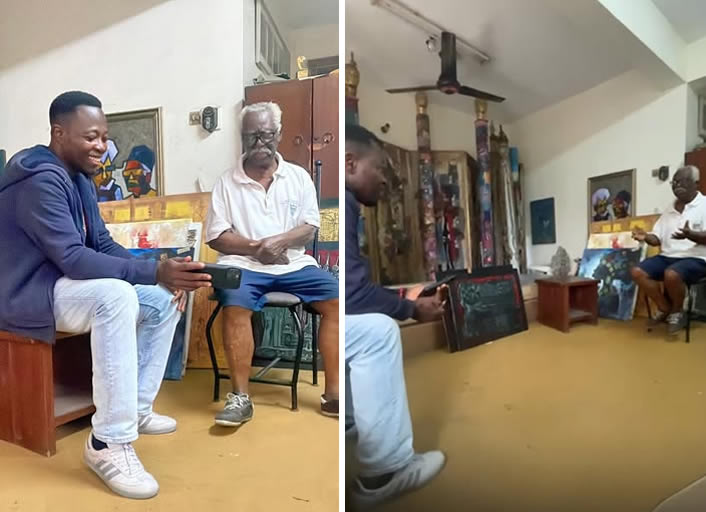Baba Bruce at 93: A Living Treasure of Innovation and Generosity. By Dr Ganiyu Jimoh Jimga

I recently had the privilege of visiting Dr. Bruce Onobrakpeya (b. 1932) in his Lagos studio, where I conducted a deeply rewarding interview on aspects of his over six-decade career in contemporary African art. Onabrakpeya is one of the pioneers of modern Nigerian art and is renowned for his innovative printmaking, leadership in the Zaria Art Society, and the Harmattan Workshop Series that has mentored generations. His global stature was affirmed with the 2006 UNESCO Living Human Treasure Award.
Fondly called Baba Bruce, he had just turned 93 last August, yet his agility — as evident in the photographs I took during my visit — is nothing short of astonishing. What struck me most, however, was not only his physical vitality but his boundless generosity of spirit. He has an insatiable desire to share knowledge, always eager to recount his experiences and artistic practices, weaving stories that stretch across time. It is a rare trait for someone of his stature, but also a hallmark of his humility. At one point, I was gently reminded that Baba had not yet taken his breakfast, and it was already nearly noon. Yet he showed no concern for himself, preferring instead to keep the conversation flowing, eager to share his insights.
My connection to his legacy had already been sharpened earlier in Washington, D.C., where I visited his recent exhibition, “Bruce Onobrakpeya – The Mask and the Cross,” at the National Museum of African Art, Smithsonian Institution. Curated by Janine Gaëlle Dieudji, the exhibition included a striking digital component that re-presented his iconic 1968 prints through 2D animation. This thoughtful curatorial gesture not only illuminated the enduring power of his work but also heightened my desire to hear directly from the legend himself about his relationship to digital art.
It is well known that Onobrakpeya has incorporated computer components into a number of his works, such as Environmental Redemption (2003) and Scavenging in a Lost Paradise (2005). Yet little has been written about his direct engagement with digital tools within digital environments, especially during the early years of Nigeria’s digital turn.
The interview was revelatory. Baba Bruce generously introduced me to some of his lesser-known works, which had been digitally remediated and later printed on canvas. I left the studio deeply moved, overwhelmed by the generosity with which he shared these hidden aspects of his practice.
As a pioneer of numerous printmaking innovations — from Plastograph to Ivorex — Onobrakpeya has never ceased to experiment. Unknown to many, he has in recent years invented a form of mixed-media painting that straddles both the digital and the conventional, a practice he calls Zerography. This latest development underscores not only his creative agility but also his enduring position at the frontier of contemporary African art. Further research into this fascinating body of work is forthcoming. Thank you for reading.
By: Dr Ganiyu Jimoh Jimga
Source
- Psychology says people who always take notes by hand instead of typing usually possess these 8 distinct traits
- The arts and humanities celebrate what makes us human
- Someone on Twitter asked why we have so many PhD holders in Nigeria...
- Theorizing Nigerian Indigenous Knowledge Systems
- The Beauty of Inaugurals
- Baba Bruce at 93: A Living Treasure of Innovation and Generosity. By Dr Ganiyu Jimoh Jimga
- Do You Sleep At All? How I Manage to Be Productive (Part III)
- Do You Sleep At All? How I Manage to Be Productive (Part II)
- Do You Sleep At All? How I Manage to Be Productive (Part I)
- Professor Inno Ụzọma Nwadike was my academic mentor and father.
- Focus on What You Can Control
- From Birthday Celebration to Lasting Legacy: How Tunji Bello Built an Auditorium for LASU
- "EXPO" TO WRITE COMMON ENTRANCE EXAMS
- Re: Called out Igbo professors in the diaspora to start talking more about their research online
- My Trip to Nigeria, By Professor Moyo Okediji
- As Artificial Intelligence (AI) takes over human roles
- Disciplinary Gatekeeping In Nigerian Universities
- “I have come a long way, and I want to sleep”: Ngugi wa Thiong’o (5 January 1938-28 May 2025)
- From Mama Africa Aquaculture to Mama Global Aquaculture: The Inspiring Journey of Ms. Foluke Areola, Global President-Elect of the World Aquaculture Society
- About Education